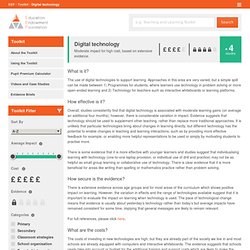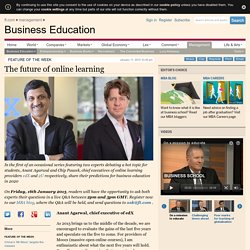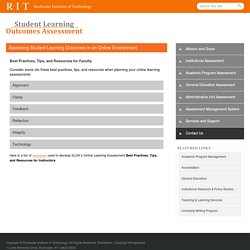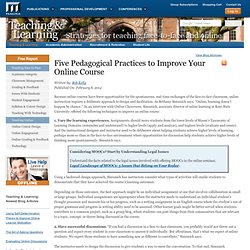

8 Things You Can Do To Improve Your Next eLearning Course. Effective eLearning courses don't happen by magic.

They come out of purposeful, thoughtful and learner-focused design. You can create those kinds of courses by following these eight simple and effective rules to instantly improve your eLearning courses. 1) Set a Learning Target Learning targets explicitly state what a learner should know or be able to do by the end of a course and how learners can demonstrate their learning.
Setting a target and a goal achieves two critical goals. What Teachers Need to Know about BYOD ( Bring Your Own Device ) Trend in Education. BYOD is the catch phrase in the 2012 educational technology spheres.

This acronym stands for " Bring Your Own Device ", I am pretty sure you might have heard of this new trend because wherever you turn you hear people talking about embracing it. I actually have been reading a lot about it to the point that I deem it important that I share with you some of what I understood from BYOD . Bring Your Own Device or BYOT ( Bring Your Own Technology ) has started in the business world with corporations encouraging their employees to bring their own technology devices such as laptops to use in the work place. Digital technology. What is it?

The use of digital technologies to support learning. Approaches in this area are very varied, but a simple split can be made between 1) Programmes for students, where learners use technology in problem solving or more open-ended learning and 2) Technology for teachers such as interactive whiteboards or learning platforms. How effective is it? The Future of Learning: Preparing for change. Create a course. Peter Norvig: The 100,000-student classroom. The future of online learning. In the first of an occasional series featuring two experts debating a hot topic for students, Anant Agarwal and Chip Paucek, chief executives of online learning providers edX and 2U respectively, share their predictions for business education in 2020 On Friday, 16th January 2015, readers will have the opportunity to ask both experts their questions in a live Q&A between 2pm and 3pm GMT.

Register now to our MBA blog, where the Q&A will be held, and send questions to ask@ft.com. Anant Agarwal, chief executive of edX. Assessing Student Learning Outcomes in an Online Environment. ALIGNMENT: Use assessments that align to learning outcomes and work well in an online environment.

Aligning the learning outcomes from your course with assessment strategies will give you the opportunity to check that your students are accomplishing the learning outcomes. Using a variety of assessment techniques throughout the course provides instructors with the best picture of their students' learning. While there is no rule about what works best, and different subject matters call for different types of assessments, the following are some generalized methods that work well in an online environment (adapted from Palloff and Pratt, 2009).
The Ten eLearning Commandments [Infographic] Malcolm Gladwell, author of ‘Outliers’ says that to truly master something takes 10,000 hours of practice.
![The Ten eLearning Commandments [Infographic]](http://cdn.pearltrees.com/s/pic/th/commandments-infographic-59565430)
That’s a long time. But while Gladwell is probably not too far off the mark, we’d add one small caveat: 10,000 hours of practicing the right way, with the right foundations. So we’ve put together the 10 commandments eLearning professionals must follow to see their courses be a success. Ten Best Practices for Teaching Online. J.

V. Boettcher, Ph.D. Designing for Learning 2006 - 2013 Minor revisions May 2011. Five Pedagogical Practices to Improve Your Online Course. Written by: Rob KellyPublished On: February 8, 2014 Because online courses have fewer opportunities for the spontaneous, real-time exchanges of the face-to-face classroom, online instruction requires a deliberate approach to design and facilitation.

As Bethany Simunich says, “Online, learning doesn’t happen by chance.” In an interview with Online Classroom, Simunich, associate director of online learning at Kent State University, offered the following techniques to improve an online course: